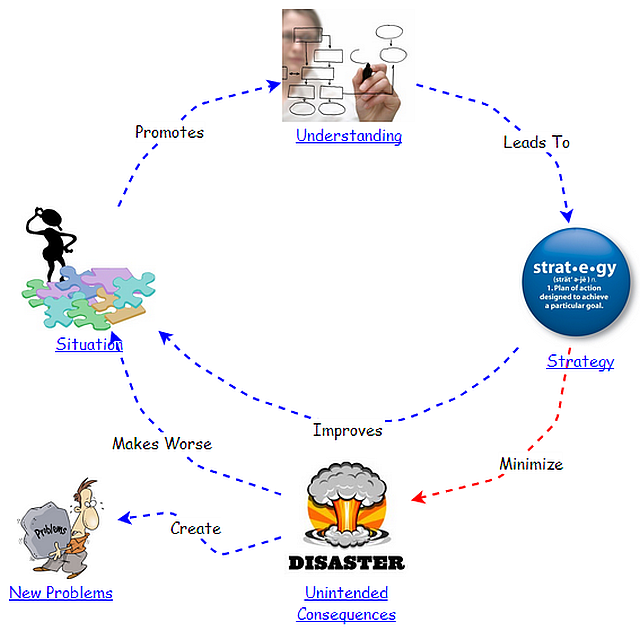
Systems thinking and modelling series: Introduction
Introducing a series of articles featuring the book Beyond Connecting the Dots, Modeling for Meaningful Results.
The helicopter view – Why systems thinking matters
We spend a good portion of our waking hours trying to figure out how to deal with situations because they are not the way we believe they should be. We think things could and should be better. Who says we don’t like change? We spend most of our careers attempting to bring about change. Though how often do our pursuits actually turn out the way we want them to? More often than not, don’t our well-intentioned actions actually end up making things worse? It is often said that the majority of today’s problems are simply the result of yesterday’s solutions. From a personal or work context you can probably painfully relate to more connections in the following diagram than you’d like to be the case.

The implications of our actions are for the most part less effective than expected because we act with an insufficient understanding of the situation we seek to change. Pogo’s quote rings true over and over, “We have met the enemy and he is us.”
If we are to stop being the victims of our own actions then we need to develop a significantly deeper understanding of situations and a capacity to act far more intelligently. The intent should be as depicted in the figure below.

Effective approaches to situations are developed based on understanding relationships and realizing that if we don’t plan to minimize unintended consequences we will most certainly be the victim of them.
Theoretically, what has been said above is easy enough to grasp the first time around. Still why is it, with a significant number of books published on problem solving and more consultants than anyone would ever want to encounter, that we continue to shoot ourselves in the foot on an ongoing basis being the poster children for Pogo’s, “we’ve met the enemy and it is us?”
A great answer to the preceding question was posed by Jay W. Forrester1 two decades ago:
I believe that confining student learning to systems thinking and to discussion about systems will convey very little understanding of the nature and behavior of the systems within which we live.
To appreciate the nature of systems, students must have extensive personal experience in working with systems. This means creating system dynamics models on a computer, simulating their behavior, exploring how the models respond to changes in structure and policies, and comparing model behavior to the real systems being represented.
To date the environment necessary to support doing what Forrester suggests has simply not been nearly as readily available as it needed to be, nor has the interactive learning environment necessary to promote this been available.
Well now it is, and it has been leveraged to produce the book Beyond Connecting the Dots, Modeling for Meaningful Results.
Beyond Connecting the Dots
Scott Fortmann-Roe, creator of Insight Maker, and Gene Bellinger, creator of SystemsWiki, have written the innovative interactive book Beyond Connecting the Dots, Modeling for Meaningful Results to demystify systems thinking and modelling.
The book makes systems thinking and modelling easily understandable and demonstrates the depth they can add to understanding and successfully interacting with the world we live in.
The authors employ innovative technology to deliver an interactive book which uses a wide range of cross-discipline models to establish a far better and enduring basis for mastering systems and feedback. This mastery is developed first though individual interaction with models and then reinforced by individuals constructing their own models.
The overall objective is to enable readers to learn how to better understand situations to produce solutions to problems so they stay solved and don’t create a myriad of new problems in the process.
In addition to a conceptual and qualitative understanding, the book provides precise instruction in quantitative model construction and evaluation. The book contains highly theoretical analyses along with “brass-tacks” applied instruction and tutorials in building and developing models.
Serialisation in RealKM Magazine
As well as having produced an innovative book, Scott Fortmann-Roe and Gene Bellinger are setting a strong example for others through providing open access to their valuable information.
Beyond Connecting the Dots is accessible online free of charge, and RealKM Magazine is pleased to bring it to you in serialised form, including links to the interactive models.
Next edition: Web of wonder: Experiencing the web.
Article sources: Kickstarter, Beyond Connecting the Dots. Reproduced by permission.
Header image source: Beyond Connecting the Dots.
Reference:
- Forrester, J. W. (1994, June). Learning through system dynamics as preparation for the 21st century. In Keynote Address for Systems Thinking and Dynamic Modelling Conference for K-12 Education. ↩
Also published on Medium.

